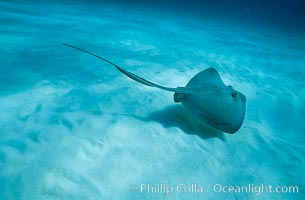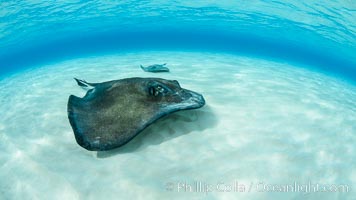
Southern Stingray, Stingray City, Grand Cayman Island.
Species: Southern stingray, Dasyatis americana
Location: Stingray City, Grand Cayman, Cayman Islands
Image ID: 32216
Species: Southern stingray, Dasyatis americana
Location: Stingray City, Grand Cayman, Cayman Islands
Image ID: 32216
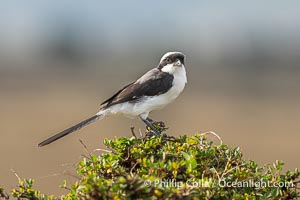
Gray-Backed Fiscal, Lanius excubitoroides, Masai Mara, Kenya.
Species: Gray-Backed Fiscal, Lanius excubitoroides
Location: Maasai Mara National Reserve, Kenya
Image ID: 39624
Species: Gray-Backed Fiscal, Lanius excubitoroides
Location: Maasai Mara National Reserve, Kenya
Image ID: 39624
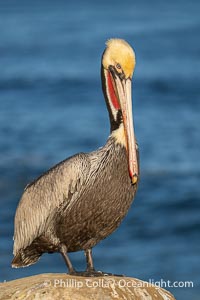
Study of a California brown pelican in winter breeding plumage, yellow head, red and olive throat, pink skin around the eye, brown hind neck with some white neck side detail, gray breast and body.
Species: Brown Pelican, Pelecanus occidentalis, Pelecanus occidentalis californicus
Location: La Jolla, California
Image ID: 39869
Species: Brown Pelican, Pelecanus occidentalis, Pelecanus occidentalis californicus
Location: La Jolla, California
Image ID: 39869
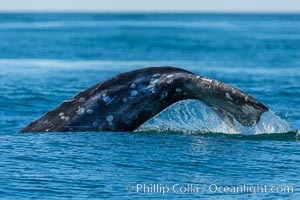
Gray whale raising fluke before diving, on southern migration to calving lagoons in Baja.
Location: San Diego, California
Image ID: 34229
Location: San Diego, California
Image ID: 34229
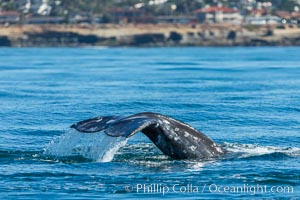
Gray whale raising fluke before diving, on southern migration to calving lagoons in Baja.
Location: San Diego, California
Image ID: 34237
Location: San Diego, California
Image ID: 34237
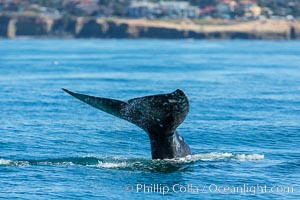
Gray whale raising fluke before diving, on southern migration to calving lagoons in Baja.
Location: San Diego, California
Image ID: 34238
Location: San Diego, California
Image ID: 34238
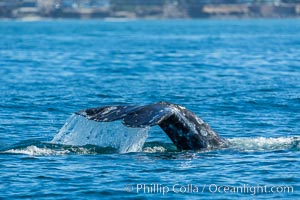
Gray whale raising fluke before diving, on southern migration to calving lagoons in Baja.
Location: San Diego, California
Image ID: 34240
Location: San Diego, California
Image ID: 34240
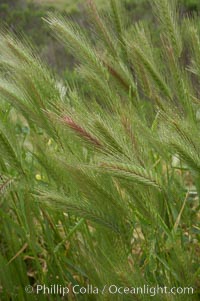
Foxtail barley.
Species: Foxtail barley, Hordeum murinum
Location: San Elijo Lagoon, Encinitas, California
Image ID: 11384
Species: Foxtail barley, Hordeum murinum
Location: San Elijo Lagoon, Encinitas, California
Image ID: 11384
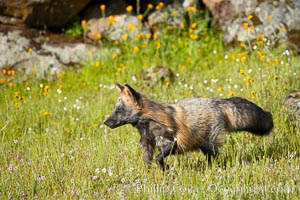
Cross fox, Sierra Nevada foothills, Mariposa, California. The cross fox is a color variation of the red fox.
Species: Red fox, Vulpes vulpes
Image ID: 15958
Species: Red fox, Vulpes vulpes
Image ID: 15958
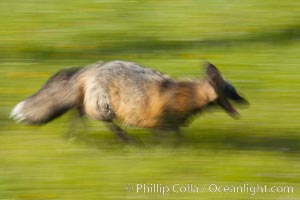
Cross fox, Sierra Nevada foothills, Mariposa, California. The cross fox is a color variation of the red fox.
Species: Red fox, Vulpes vulpes
Image ID: 15959
Species: Red fox, Vulpes vulpes
Image ID: 15959
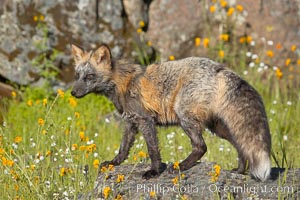
Cross fox, Sierra Nevada foothills, Mariposa, California. The cross fox is a color variation of the red fox.
Species: Red fox, Vulpes vulpes
Image ID: 15961
Species: Red fox, Vulpes vulpes
Image ID: 15961
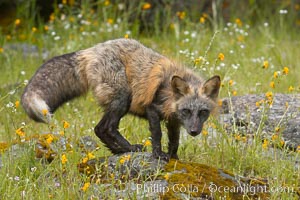
Cross fox, Sierra Nevada foothills, Mariposa, California. The cross fox is a color variation of the red fox.
Species: Red fox, Vulpes vulpes
Image ID: 15962
Species: Red fox, Vulpes vulpes
Image ID: 15962
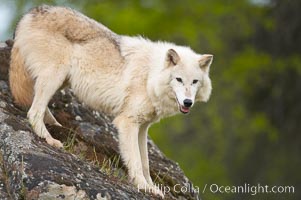
Gray wolf, Sierra Nevada foothills, Mariposa, California.
Species: Gray wolf, Canis lupus
Image ID: 16024
Species: Gray wolf, Canis lupus
Image ID: 16024
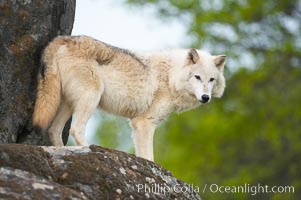
Gray wolf, Sierra Nevada foothills, Mariposa, California.
Species: Gray wolf, Canis lupus
Image ID: 16042
Species: Gray wolf, Canis lupus
Image ID: 16042
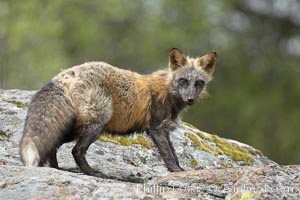
Cross fox, Sierra Nevada foothills, Mariposa, California. The cross fox is a color variation of the red fox.
Species: Red fox, Vulpes vulpes
Image ID: 15955
Species: Red fox, Vulpes vulpes
Image ID: 15955
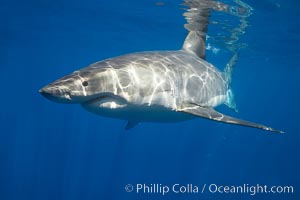
A great white shark is countershaded, with a dark gray dorsal color and light gray to white underside, making it more difficult for the shark's prey to see it as approaches from above or below in the water column. The particular undulations of the countershading line along its side, where gray meets white, is unique to each shark and helps researchers to identify individual sharks in capture-recapture studies. Guadalupe Island is host to a relatively large population of great white sharks who, through a history of video and photographs showing their countershading lines, are the subject of an ongoing study of shark behaviour, migration and population size.
Species: Great white shark, Carcharodon carcharias
Location: Guadalupe Island (Isla Guadalupe), Baja California, Mexico
Image ID: 19455
Species: Great white shark, Carcharodon carcharias
Location: Guadalupe Island (Isla Guadalupe), Baja California, Mexico
Image ID: 19455
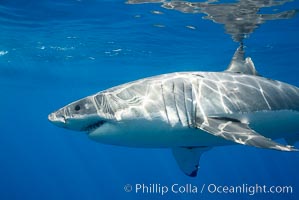
A great white shark is countershaded, with a dark gray dorsal color and light gray to white underside, making it more difficult for the shark's prey to see it as approaches from above or below in the water column. The particular undulations of the countershading line along its side, where gray meets white, is unique to each shark and helps researchers to identify individual sharks in capture-recapture studies. Guadalupe Island is host to a relatively large population of great white sharks who, through a history of video and photographs showing their countershading lines, are the subject of an ongoing study of shark behaviour, migration and population size.
Species: Great white shark, Carcharodon carcharias
Location: Guadalupe Island (Isla Guadalupe), Baja California, Mexico
Image ID: 19456
Species: Great white shark, Carcharodon carcharias
Location: Guadalupe Island (Isla Guadalupe), Baja California, Mexico
Image ID: 19456
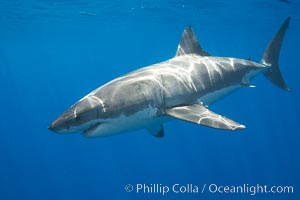
A great white shark is countershaded, with a dark gray dorsal color and light gray to white underside, making it more difficult for the shark's prey to see it as approaches from above or below in the water column. The particular undulations of the countershading line along its side, where gray meets white, is unique to each shark and helps researchers to identify individual sharks in capture-recapture studies. Guadalupe Island is host to a relatively large population of great white sharks who, through a history of video and photographs showing their countershading lines, are the subject of an ongoing study of shark behaviour, migration and population size.
Species: Great white shark, Carcharodon carcharias
Location: Guadalupe Island (Isla Guadalupe), Baja California, Mexico
Image ID: 19458
Species: Great white shark, Carcharodon carcharias
Location: Guadalupe Island (Isla Guadalupe), Baja California, Mexico
Image ID: 19458
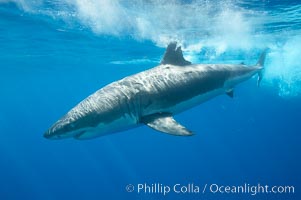
A great white shark is countershaded, with a dark gray dorsal color and light gray to white underside, making it more difficult for the shark's prey to see it as approaches from above or below in the water column. The particular undulations of the countershading line along its side, where gray meets white, is unique to each shark and helps researchers to identify individual sharks in capture-recapture studies. Guadalupe Island is host to a relatively large population of great white sharks who, through a history of video and photographs showing their countershading lines, are the subject of an ongoing study of shark behaviour, migration and population size.
Species: Great white shark, Carcharodon carcharias
Location: Guadalupe Island (Isla Guadalupe), Baja California, Mexico
Image ID: 19459
Species: Great white shark, Carcharodon carcharias
Location: Guadalupe Island (Isla Guadalupe), Baja California, Mexico
Image ID: 19459
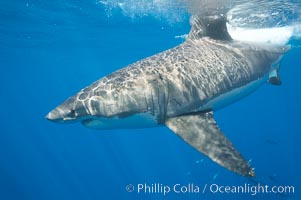
A great white shark is countershaded, with a dark gray dorsal color and light gray to white underside, making it more difficult for the shark's prey to see it as approaches from above or below in the water column. The particular undulations of the countershading line along its side, where gray meets white, is unique to each shark and helps researchers to identify individual sharks in capture-recapture studies. Guadalupe Island is host to a relatively large population of great white sharks who, through a history of video and photographs showing their countershading lines, are the subject of an ongoing study of shark behaviour, migration and population size.
Species: Great white shark, Carcharodon carcharias
Location: Guadalupe Island (Isla Guadalupe), Baja California, Mexico
Image ID: 19460
Species: Great white shark, Carcharodon carcharias
Location: Guadalupe Island (Isla Guadalupe), Baja California, Mexico
Image ID: 19460
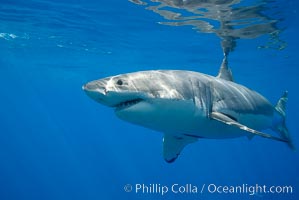
A great white shark is countershaded, with a dark gray dorsal color and light gray to white underside, making it more difficult for the shark's prey to see it as approaches from above or below in the water column. The particular undulations of the countershading line along its side, where gray meets white, is unique to each shark and helps researchers to identify individual sharks in capture-recapture studies. Guadalupe Island is host to a relatively large population of great white sharks who, through a history of video and photographs showing their countershading lines, are the subject of an ongoing study of shark behaviour, migration and population size.
Species: Great white shark, Carcharodon carcharias
Location: Guadalupe Island (Isla Guadalupe), Baja California, Mexico
Image ID: 19463
Species: Great white shark, Carcharodon carcharias
Location: Guadalupe Island (Isla Guadalupe), Baja California, Mexico
Image ID: 19463
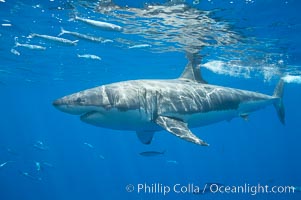
A great white shark is countershaded, with a dark gray dorsal color and light gray to white underside, making it more difficult for the shark's prey to see it as approaches from above or below in the water column. The particular undulations of the countershading line along its side, where gray meets white, is unique to each shark and helps researchers to identify individual sharks in capture-recapture studies. Guadalupe Island is host to a relatively large population of great white sharks who, through a history of video and photographs showing their countershading lines, are the subject of an ongoing study of shark behaviour, migration and population size.
Species: Great white shark, Carcharodon carcharias
Location: Guadalupe Island (Isla Guadalupe), Baja California, Mexico
Image ID: 19464
Species: Great white shark, Carcharodon carcharias
Location: Guadalupe Island (Isla Guadalupe), Baja California, Mexico
Image ID: 19464
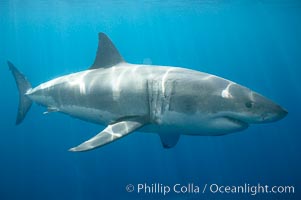
A great white shark is countershaded, with a dark gray dorsal color and light gray to white underside, making it more difficult for the shark's prey to see it as approaches from above or below in the water column. The particular undulations of the countershading line along its side, where gray meets white, is unique to each shark and helps researchers to identify individual sharks in capture-recapture studies. Guadalupe Island is host to a relatively large population of great white sharks who, through a history of video and photographs showing their countershading lines, are the subject of an ongoing study of shark behaviour, migration and population size.
Species: Great white shark, Carcharodon carcharias
Location: Guadalupe Island (Isla Guadalupe), Baja California, Mexico
Image ID: 19467
Species: Great white shark, Carcharodon carcharias
Location: Guadalupe Island (Isla Guadalupe), Baja California, Mexico
Image ID: 19467
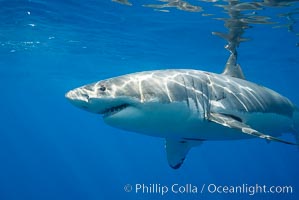
A great white shark is countershaded, with a dark gray dorsal color and light gray to white underside, making it more difficult for the shark's prey to see it as approaches from above or below in the water column. The particular undulations of the countershading line along its side, where gray meets white, is unique to each shark and helps researchers to identify individual sharks in capture-recapture studies. Guadalupe Island is host to a relatively large population of great white sharks who, through a history of video and photographs showing their countershading lines, are the subject of an ongoing study of shark behaviour, migration and population size.
Species: Great white shark, Carcharodon carcharias
Location: Guadalupe Island (Isla Guadalupe), Baja California, Mexico
Image ID: 19471
Species: Great white shark, Carcharodon carcharias
Location: Guadalupe Island (Isla Guadalupe), Baja California, Mexico
Image ID: 19471
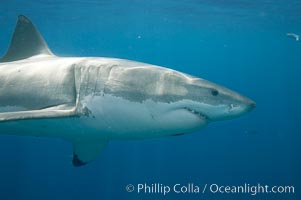
A great white shark is countershaded, with a dark gray dorsal color and light gray to white underside, making it more difficult for the shark's prey to see it as approaches from above or below in the water column. The particular undulations of the countershading line along its side, where gray meets white, is unique to each shark and helps researchers to identify individual sharks in capture-recapture studies. Guadalupe Island is host to a relatively large population of great white sharks who, through a history of video and photographs showing their countershading lines, are the subject of an ongoing study of shark behaviour, migration and population size.
Species: Great white shark, Carcharodon carcharias
Location: Guadalupe Island (Isla Guadalupe), Baja California, Mexico
Image ID: 19474
Species: Great white shark, Carcharodon carcharias
Location: Guadalupe Island (Isla Guadalupe), Baja California, Mexico
Image ID: 19474
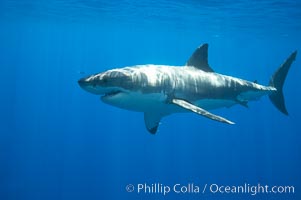
A great white shark is countershaded, with a dark gray dorsal color and light gray to white underside, making it more difficult for the shark's prey to see it as approaches from above or below in the water column. The particular undulations of the countershading line along its side, where gray meets white, is unique to each shark and helps researchers to identify individual sharks in capture-recapture studies. Guadalupe Island is host to a relatively large population of great white sharks who, through a history of video and photographs showing their countershading lines, are the subject of an ongoing study of shark behaviour, migration and population size.
Species: Great white shark, Carcharodon carcharias
Location: Guadalupe Island (Isla Guadalupe), Baja California, Mexico
Image ID: 19481
Species: Great white shark, Carcharodon carcharias
Location: Guadalupe Island (Isla Guadalupe), Baja California, Mexico
Image ID: 19481
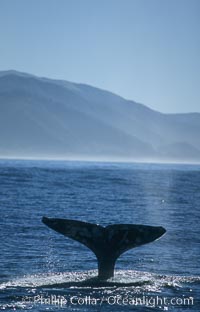
Gray whale.
Species: Gray whale, Eschrichtius robustus
Location: Big Sur, California
Image ID: 01182
Species: Gray whale, Eschrichtius robustus
Location: Big Sur, California
Image ID: 01182
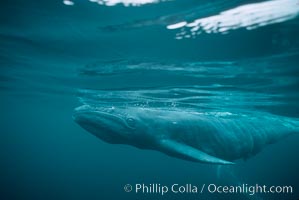
Gray whale, neonate calf with embryonic folds visible.
Species: Gray whale, Eschrichtius robustus
Location: Monterey, California
Image ID: 01129
Species: Gray whale, Eschrichtius robustus
Location: Monterey, California
Image ID: 01129
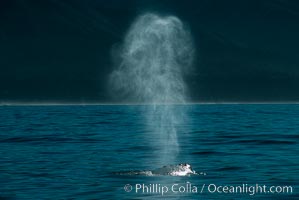
Gray whale, blow.
Species: Gray whale, Eschrichtius robustus
Location: Big Sur, California
Image ID: 01170
Species: Gray whale, Eschrichtius robustus
Location: Big Sur, California
Image ID: 01170
